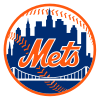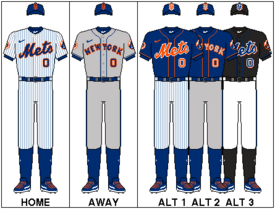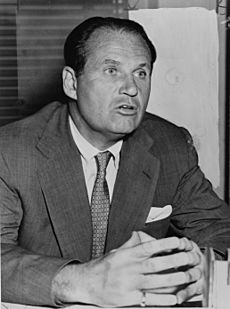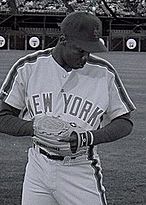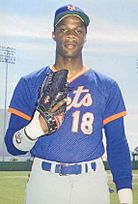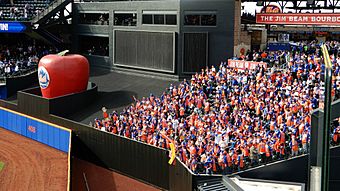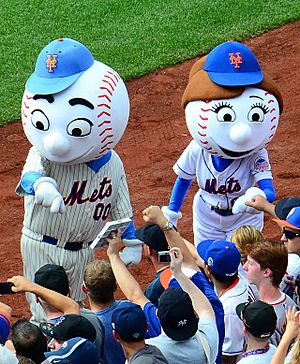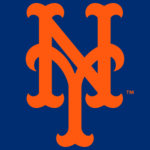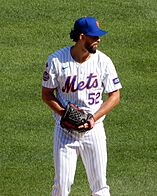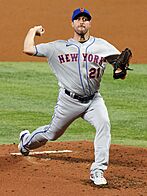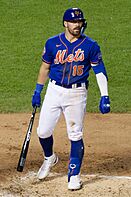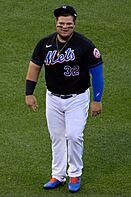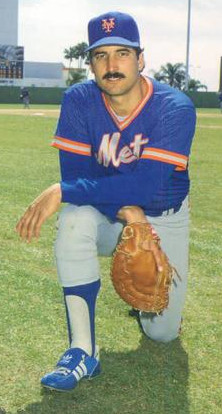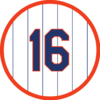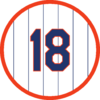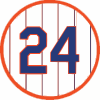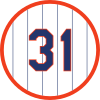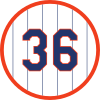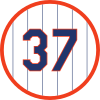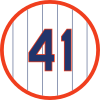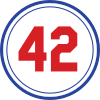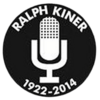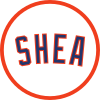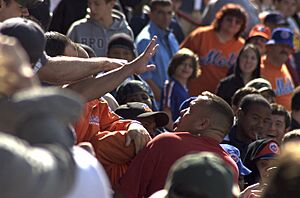New York Mets facts for kids
Quick facts for kids New York Mets |
|||||
|---|---|---|---|---|---|
|
|||||
|
|||||
| Major league affiliations | |||||
|
|||||
| Current uniform | |||||
| Retired numbers | |||||
| Colors | |||||
|
|||||
| Name | |||||
|
|||||
| Other nicknames | |||||
|
|||||
| Ballpark | |||||
|
|||||
| Major league titles | |||||
| World Series titles (2) |
|
||||
| NL Pennants (5) |
|
||||
| NL East Division titles (6) |
|
||||
| Wild card berths (5) |
|
||||
| Front office | |||||
| Principal owner(s) | Steve Cohen Alexandra M. Cohen |
||||
| President | Steve Cohen (CEO) | ||||
| President of baseball operations | David Stearns | ||||
| General manager | Vacant | ||||
| Manager | Carlos Mendoza | ||||
The New York Mets are a professional baseball team from Queens, New York City. They play in Major League Baseball (MLB) as part of the National League (NL) East Division. The Mets are one of two MLB teams in New York City, the other being the New York Yankees from the American League.
The Mets started in 1962 as one of baseball's first expansion teams. They were created to replace New York's older NL teams, the Brooklyn Dodgers and the New York Giants, which had moved to California. The Mets' team colors, blue and orange, were chosen to honor these two former New York teams. Blue came from the Dodgers, and orange came from the Giants.
For their first two seasons (1962 and 1963), the Mets played their home games at the Polo Grounds in Manhattan. From 1964 to 2008, they played at Shea Stadium. This stadium was named after William Shea, who helped bring National League baseball back to New York. Since 2009, the Mets have played at Citi Field, which is right next to where Shea Stadium used to be.
In their very first season in 1962, the Mets had a tough start, losing 120 games. This was one of the most losses in MLB history for a 162-game season. However, in 1969, the team, nicknamed the "Miracle Mets," surprised everyone. They won the 1969 World Series against the Baltimore Orioles, which is still considered one of baseball's biggest upsets.
The Mets have made it to the postseason eleven times. They have won the World Series twice (in 1969 and 1986). They have also won five National League pennants (most recently in 2000 and 2015) and six National League East division titles.
Since 2020, the Mets have been owned by Steve Cohen. He bought the team for $2.4 billion. As of 2025, the Mets are ranked as one of the most valuable teams in MLB.
Contents
Team History
Early Years and First Championship (1960s)
After the 1957 season, the Brooklyn Dodgers and New York Giants moved from New York to California. This left New York City with only one major league team, the New York Yankees. To bring National League baseball back, the league added the New York Mets in 1962. This happened after William Shea proposed a new league.
The Mets chose blue from the Dodgers and orange from the Giants as their main colors. These colors are also on the flag of New York City. The team's nickname, "Mets," is short for "New York Metropolitan Baseball Club, Inc." This name also honored an old New York team called the "New York Metropolitans."
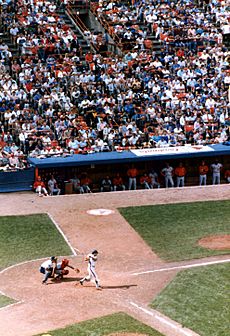
The 1962 Mets had a very difficult season, finishing with 40 wins and 120 losses. In 1963, the team had some good players like pitcher Carlton Willey and veteran Duke Snider. In 1964, Yogi Berra joined the Mets as a coach.
In 1967, the Mets got future Hall of Famer Tom Seaver in a special lottery. Seaver became a key player. He helped the 1969 "Miracle Mets" win their division. They then beat the Atlanta Braves to win the National League pennant. Finally, they defeated the strong Baltimore Orioles to win the 1969 World Series. This was a huge upset.
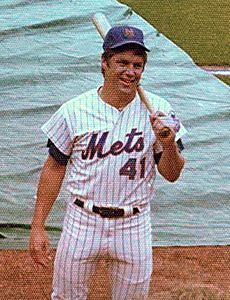
Second Pennant and Changes (1970s)
In 1973, the Mets made a surprising comeback. They won their division despite having a record of only 82 wins and 79 losses. They then beat the powerful Cincinnati Reds in the NLCS. The Mets went on to play the defending World Series champions, the Oakland Athletics, in the World Series. They pushed the series to a seventh game but lost.
In 1977, star pitcher Tom Seaver was traded away. This event is often called "the Midnight Massacre." After this trade, the Mets struggled for several years, often finishing in last place.
Rise to Success and Second World Series (1980s)
In 1980, the Mets team was sold to the Doubleday publishing company. Fred Wilpon became the team president. He hired Frank Cashen as general manager, who started to rebuild the team.
The Mets became very strong in the mid-1980s. They drafted talented players like slugger Darryl Strawberry (in 1980) and pitcher Dwight Gooden (in 1982). They also got Keith Hernandez, a great first baseman, from the St. Louis Cardinals in 1983. This started a big rivalry between the Mets and Cardinals.
In 1984, new manager Davey Johnson led the Mets to a winning record for the first time since 1976. In 1985, they added Hall of Fame catcher Gary Carter and won 98 games, but just missed the playoffs.
In 1986, the Mets had an amazing season, winning 108 games. This was one of the best records in National League history. They then won a thrilling NLCS against the Houston Astros. The sixth game of that series lasted 16 innings, which was the longest playoff game at the time.
The Mets then faced the Boston Red Sox in the 1986 World Series. In Game 6, the Mets were very close to losing. But a series of hits and a famous error by Boston's Bill Buckner helped the Mets win the game. The Mets went on to win their second World Series title in seven games.
In 1988, the Mets won 100 games and their division again. However, they lost in the 1988 NLCS to the Los Angeles Dodgers. After this, the team's performance declined into the 1990s.
Challenges and Return to Playoffs (1990s)
The early 1990s were tough for the Mets. They tried to build a team by signing expensive star players like Eddie Murray and Bobby Bonilla. However, many players got injured or had difficulties. This period was even called "The Worst Team Money Could Buy" in a book.
Despite these challenges, some players shined. In 1991, David Cone pitched a one-hit shutout, striking out 19 batters. This tied a National League record.
The Mets had a very difficult 1993 season, losing 103 games. Young pitcher Anthony Young set a record with 27 straight losses over two years.
In 1994, the season was cut short by a strike. The Mets were in third place when the season ended. In 1995, the team showed some improvement, finishing second in their division. This season also saw the rise of young pitchers Bill Pulsipher, Jason Isringhausen, and Paul Wilson, nicknamed "Generation K." However, injuries kept them from reaching their full potential.
In 1996, Todd Hundley set a new MLB record for home runs by a catcher with 41. Lance Johnson also set franchise records for hits and triples.
In 1997, the Mets improved significantly, winning 88 games. They just missed the playoffs. This year also saw the first regular-season game between the Mets and the New York Yankees, with the Mets winning 6–0.
The 1998 season started with a very long opening day game against the Philadelphia Phillies, which the Mets won in 14 innings. During this season, the Mets acquired star catcher Mike Piazza in a big trade. Piazza brought new excitement and skill to the team. The Mets played well after the trade but missed the playoffs by just one game.
In 1999, the Mets had a strong season. Mike Piazza and Robin Ventura had excellent years. The team made it to a one-game playoff against the Cincinnati Reds to get into the postseason. Al Leiter pitched a great game, and the Mets won. They then defeated the Arizona Diamondbacks in the first round of the playoffs. The Mets eventually lost to the Atlanta Braves in the 1999 National League Championship Series, but it was a very exciting series.
Subway Series and New Ballpark (2000s)
In 2000, the Mets earned a wild card spot in the playoffs. They defeated the San Francisco Giants and the St Louis Cardinals to win the National League pennant. This led to a "Subway Series" in the 2000 World Series against their crosstown rivals, the New York Yankees. The Yankees won the series in five games. A memorable moment happened when Yankees pitcher Roger Clemens threw a broken bat piece towards Mike Piazza.
In 2001, the Mets finished third in their division. After the September 11 attacks, Shea Stadium was used as a relief center. On September 21, the Mets played the first sporting event in New York City since the attacks. In a dramatic moment, Mike Piazza hit a home run in the 8th inning to give the Mets the win. This game is considered one of the greatest moments in team history.
The Mets struggled in 2002, finishing last in their division. However, in 2005, they hired a new general manager, Omar Minaya, and a new manager, Willie Randolph. They also signed star pitcher Pedro Martínez. The team improved, and by 2006, they won 97 games and the NL East title. Key players included Carlos Beltrán, Carlos Delgado, José Reyes, and David Wright. The Mets lost to the St. Louis Cardinals in Game 7 of the 2006 National League Championship Series.
In 2007 and 2008, the Mets had strong leads late in the season but lost them, missing the playoffs both times. 2008 was their final season at Shea Stadium.
In 2009, the Mets moved into their new home, Citi Field. The season was difficult due to many player injuries. Despite this, the team finished with the best batting average in the National League.
Ownership Change and World Series Appearance (2010s)
In 2012, the Mets owners settled a lawsuit related to the Bernard Madoff investment scheme. This period also saw some important team milestones. Johan Santana pitched the first no-hitter in Mets history in 2012. That same year, R.A. Dickey won the NL Cy Young Award for being the best pitcher.
On September 26, 2015, the Mets won the NL East division title, making it to the postseason for the first time since 2006. They defeated the Los Angeles Dodgers in the first round and then swept the Chicago Cubs to win their first pennant in 15 years. In the 2015 World Series, they lost to the Kansas City Royals in five games.
The Mets returned to the postseason in 2016, which was only the second time in team history they made the playoffs in back-to-back years. They lost the 2016 National League Wild Card Game to the San Francisco Giants. The Mets did not make the playoffs for the rest of the decade.
Towards the end of the 2010s, David Wright retired. Jacob deGrom won two straight Cy Young Awards in 2018 and 2019. First baseman Pete Alonso won the 2019 Major League Baseball Rookie of the Year Award and hit 53 home runs, setting a new MLB rookie record.
The Steve Cohen Era (2020s)
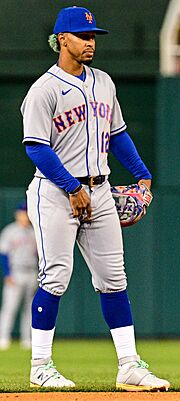
In January 2020, Carlos Beltrán stepped down as manager. Two days later, the Mets hired Luis Rojas. The 2020 season was shorter due to world events, and the Mets finished last in their division.
On October 30, 2020, Steve Cohen became the main owner of the Mets. He bought 95% of the team for $2.4 billion, making him the richest owner in baseball.
In January 2021, the Mets acquired pitcher Carlos Carrasco and All-Star shortstop Francisco Lindor. Lindor then signed a 10-year contract extension with the team. The Mets also traded for All-Star infielder Javier Báez. The team finished third in their division in 2021.
In November 2021, the Mets hired Billy Eppler as their new general manager. They signed several new players, including three-time Cy Young Award winner Max Scherzer. In December, the Mets announced Buck Showalter as their new manager.
On April 29, 2022, several Mets pitchers combined to throw the second no-hitter in franchise history against the Philadelphia Phillies. On September 18, Jacob deGrom set a new MLB record by allowing three or fewer earned runs in 40 straight games.
The Mets made the postseason in 2022, their 10th time in franchise history. Pete Alonso broke the Mets' single-season RBI record. The Mets won 101 games, tying for the best record in their division. However, they were a Wild Card team and lost to the San Diego Padres in the 2022 National League Wild Card Series.
In the offseason, deGrom left the Mets, but they signed Japanese pitcher Kodai Senga and three-time Cy Young Award winner Justin Verlander. Despite these additions, the Mets missed the playoffs in 2023.
On September 12, 2023, the Mets hired David Stearns as their new president of baseball operations. After the 2023 season, manager Buck Showalter was fired. In November 2023, the Mets named Carlos Mendoza as their new manager.
In the 2024 season, the Mets started slowly but improved greatly after a team meeting. They finished with a strong record and qualified for the playoffs for the second time in three years. They reached the 2024 National League Championship Series before losing to the eventual World Series champion Los Angeles Dodgers.
On December 8, 2024, the Mets signed superstar outfielder Juan Soto to a 15-year, $765 million contract. This was the largest contract in professional sports history. Many believe this deal marks a new and exciting era for the Mets and New York baseball.
World Series Championships

The Mets have won two World Series championships in their history.
|
||||||||||||||||||||
Team Culture
Fan Support
Mets fans come from all over New York City and the surrounding areas. Many fans live in Queens, Brooklyn, and Long Island. Famous Mets fans include Jerry Seinfeld, Kevin James, Julia Stiles, Jon Stewart, and Billy Joel.
The 7 Line Army
The "7 Line Army" is a group of very enthusiastic Mets fans. They sit in a special section at Citi Field during home games. The group was started in 2012 by Darren Meenan, who owns a company that makes Mets-themed clothing.
Mascots
Mr. Met is the official mascot of the New York Mets. He first appeared on game programs in 1963. When the Mets moved to Shea Stadium in 1964, a live costumed version of Mr. Met was introduced. He is thought to be the first mascot in Major League Baseball to be a costumed character.
Mrs. Met is the female version of Mr. Met. They sometimes appear with their "children" mascots.
The Mets have had other mascots too. Homer, a beagle dog, was the original mascot in the early 1960s. Mettle the mule represented the team in 1979.
Theme Song
"Meet the Mets" is the Mets' well-known song. It was written in 1961, before the team's first season. It is played on the radio, during TV broadcasts, and at Mets home games. Other songs played at games include "Take Me Out to the Ball Game" and "Lazy Mary" during the seventh-inning stretch. Billy Joel's "Piano Man" is played in the middle of the eighth inning.
"Let's Go Mets" Meme
In 2021, a popular internet meme started spreading on social media. It involves fictional characters unexpectedly showing support for the Mets by saying "let's go, Mets."
Uniform and Logo Design
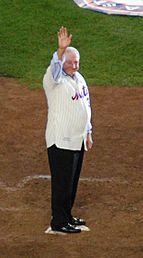
The Mets' colors are blue and orange. These colors were chosen to honor New York City's baseball history. Blue came from the Brooklyn Dodgers, and orange came from the New York Giants. Blue and orange are also the colors of New York City's flag.
In 1998, black was added to the team's colors. However, black was mostly removed from the uniforms between 2012 and 2013. In 2021, black was brought back for some alternate uniforms.
Team Logo
The main Mets logo was designed by cartoonist Ray Gotto. It shows "Mets" written in orange letters across a blue image of the New York City skyline. A white suspension bridge is in front of the skyline. The whole design is inside an orange circle with baseball stitching.
Each part of the skyline has a special meaning:
- A church spire on the left represents Brooklyn.
- The second building is the Williamsburgh Savings Bank Building, which was the tallest in Brooklyn when the team started.
- Next is the Woolworth Building.
- Then, a general view of midtown New York.
- The Empire State Building is also shown.
- On the far right is the headquarters of the United Nations.
- The suspension bridge in the middle shows that the Mets represent all five boroughs of New York City.
In 1999, a small "NY" that was next to the "Mets" script was removed from the logo. When black was added as a team color, an alternate logo was made with a black skyline. This black logo was not used for a while but returned in 2021 on the black jerseys.
The cap logo is an orange, interlocking "NY." This is similar to the logo used by the old New York Giants. The cap itself is blue, like the caps worn by the Brooklyn Dodgers.
Uniform Colors and Designs
The Mets wear different uniforms.
- Home Uniforms: These are white with blue pinstripes. They have "Mets" written in blue with an orange outline across the chest. Player names and numbers are also blue with an orange outline. They wear a blue cap with an orange "NY" logo.
- Road Uniforms: Introduced in 2025, these are gray with blue and orange stripes. They have "NEW YORK" written across the chest in blue with an orange outline. Player names and numbers are also blue with an orange outline. They wear the same blue caps as the home uniforms.
- Black Alternate Home Jersey: This jersey was brought back in 2021 for Friday home games. It has the "Mets" script and player names/numbers in blue with orange outlines. It is worn with a black cap that has a blue "NY" logo with an orange trim.
- Blue Alternate Road Jersey: Introduced in 2025, this pullover jersey has "New York" in script across the chest. It has blue and orange stripes on the collar and sleeves. It is worn with the blue caps.
- City Connect Jersey: This dark gray jersey with black and purple accents was introduced in 2024. It has "NYC" on the front and black pinstripes. The purple color is inspired by the 7 Line subway that goes to Citi Field.
Key Players and Honors
Team Captains

Four players have been team captains for the Mets:
- Keith Hernandez, 1987–1989 (co-captain with Gary Carter)
- Gary Carter, 1988–1989 (co-captain with Keith Hernandez)
- John Franco, 2001–2004
- David Wright, 2013–2018
Hall of Famers
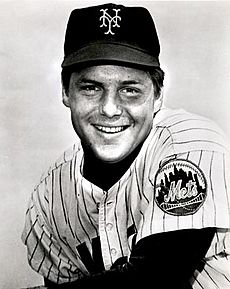

Many great players who played for the Mets are in the Baseball Hall of Fame. Some of them are known mostly for their time with the Mets, like Tom Seaver and Mike Piazza. Others played for the Mets during part of their careers, such as Roberto Alomar, Gary Carter, Rickey Henderson, and Willie Mays.
Retired Numbers
The Mets have retired ten numbers to honor important players and figures in their history. When a number is retired, no other player on the team can wear it again.
|
Jackie Robinson's number 42 was retired by all of Major League Baseball on April 15, 1997. The Mets also honor William Shea for his important role in bringing the team to New York.
Recently, the Mets have retired more numbers:
- Jerry Koosman's number 36 was retired on August 28, 2021.
- Keith Hernandez's number 17 was retired on July 9, 2022.
- Willie Mays's number 24 was retired on August 27, 2022.
- Broadcasters Ralph Kiner and Bob Murphy are also honored with special microphone logos.
- Dwight Gooden's number 16 was retired on April 14, 2024.
- Darryl Strawberry's number 18 was retired on June 1, 2024.
- David Wright's number 5 was retired on July 19, 2025.
Numbers Not Issued But Not Officially Retired
- 8: This number has not been given to a player since Gary Carter was elected to the Hall of Fame in 2003. While not officially retired, the Mets honor Carter's legacy.
Mets Hall of Fame
The Mets have their own Hall of Fame to honor players, managers, and others who have made a big impact on the team.
| Year | Year inducted |
|---|---|
| Bold | Member of the Baseball Hall of Fame |
|
|
Member of the Baseball Hall of Fame as a Met |
| Bold | Recipient of the Hall of Fame's Ford C. Frick Award |
| Year | No. | Name | Position(s) | Tenure |
|---|---|---|---|---|
| 1981 | — | Joan Whitney Payson | Owner President |
1960–1975 1968–1975 |
| 37 | Casey Stengel | Manager VP |
1962–1965 1965–1975 |
|
| 1982 | 14 | Gil Hodges | 1B Manager |
1962–1963 1968–1971 |
| — | George Weiss | President | 1961–1966 | |
| 1983 | — | Johnny Murphy | Chief Scout VP VP & GM |
1961–1963 1964–1967 1968–1970 |
| — | William Shea | Proponent | ||
| 1984 | — | Ralph Kiner | Broadcaster | 1962–2013 |
| — | Bob Murphy |
Broadcaster | 1962–2003 | |
| — | Lindsey Nelson |
Broadcaster | 1962–1978 | |
| 1986 | 3, 23, 53 | Bud Harrelson | SS Coach Manager |
1965–1977 1982, 1985–1990 1990–1991 |
| 4, 10 | Rusty Staub | RF / 1B | 1972–1975, 1981–1985 | |
| 1988 | 41 | Tom Seaver |
P Broadcaster |
1967–1977, 1983 1999–2005 |
| 1989 | 36, 47 | Jerry Koosman | P | 1967–1978 |
| 1990 | 7, 21 | Ed Kranepool | 1B | 1962–1979 |
| 1991 | 12, 21, 34 | Cleon Jones | LF | 1963, 1965–1975 |
| 1992 | 15 | Jerry Grote | C | 1966–1977 |
| 1993 | 45 | Tug McGraw | P | 1965–1967, 1969–1974 |
| 1996 | 1, 51 | Mookie Wilson | CF Coach |
1980–1989 1997–2002, 2011 |
| 1997 | 17 | Keith Hernandez | 1B Broadcaster |
1983–1989 2006–present |
| 2001 | 8 | Gary Carter | C | 1985–1989 |
| 2002 | 20 | Tommie Agee | CF | 1968–1972 |
| 2010 | — | Frank Cashen | GM & COO | 1980–1991 |
| 16 | Dwight Gooden | P | 1984–1994 | |
| 5 | Davey Johnson | Manager | 1984–1990 | |
| 18 | Darryl Strawberry | RF | 1983–1990 | |
| 2012 | 31, 45 | John Franco | P | 1990–2004 |
| 2013 | 31 | Mike Piazza |
C | 1998–2005 |
| 2020/2021 | 13 | Edgardo Alfonzo | 2B / 3B | 1995–2002 |
| 12 | Ron Darling | P Broadcaster |
1983–1991 2006–present |
|
| 32 | Jon Matlack | P | 1971–1977 | |
| 2023 | – | Gary Cohen | Broadcaster | 1989–present |
| 20, 44 | Howard Johnson | 3B / SS / LF / RF | 1985–1993 | |
| 22 | Al Leiter | P | 1998–2004 | |
| – | Howie Rose | Broadcaster | 1987–present | |
| 2025 | 5 | David Wright | 3B | 2004–2016, 2018 |
Team Rivalries
The Mets have strong rivalries with the Atlanta Braves, the New York Yankees, and the Philadelphia Phillies.
Subway Series (Mets vs. Yankees)
The rivalry between the Mets and the New York Yankees is called the "Subway Series". This name comes from the fact that both teams are in New York City and fans can take the subway to see their games. Before 1997, these teams only played in exhibition games. Now, they play each other every regular season. They even faced off in the 2000 World Series.
Mets vs. Atlanta Braves
The rivalry between the Mets and the Atlanta Braves became strong in the 1990s. This happened when both teams were placed in the same division, the National League East. They played against each other in the 1969 playoffs, with the Mets winning. They met again in the 1999 National League Championship Series, which the Braves won.
Mets vs. Philadelphia Phillies
The rivalry between the Mets and the Philadelphia Phillies has been very intense, especially from 2006 to 2008. These two cities are close by, and their sports teams often have strong rivalries in many sports. Games between the Mets and Phillies are often very competitive.
Mets vs. St. Louis Cardinals
The rivalry between the St. Louis Cardinals and the Mets was strongest in the 1980s. Both teams were competing for the top spot in the National League East. This rivalry began when Keith Hernandez was traded from the Cardinals to the Mets in 1983. The Cardinals were moved to a different division in 1994, and the rivalry became less intense. However, the teams met again in the playoffs in 2000 and 2006.
Team Personnel
|
New York Mets 2023 spring training roster
|
||||||
|---|---|---|---|---|---|---|
| 40-man roster | Non-roster invitees | Coaches/Other | ||||
|
Pitchers
|
Catchers
Infielders
Outfielders
Designated hitters
|
Pitchers
Infielders
Outfielders
|
Manager Coaches
40 active, 0 inactive, 7 non-roster invitees
|
|||
Mets Foundation
The New York Mets Foundation is a charity organization run by the team. It was started in 1963 and helps many good causes in the Mets community. One of the groups they support is Tuesday's Children, which helps families affected by the events of September 11, 2001. The Mets Foundation raises money through events like the annual Welcome Home Dinner.
Owners and Executives
- Owners: Steven A. Cohen and Alex Cohen
- President of Baseball Operations: David Stearns
- Special Assistant to the President of Baseball Operations: Carlos Beltran
- Vice President: Eduardo Brizuela
- Vice President, Player Development: Andy Green
Mets Broadcasters
Television Broadcasts
Most Mets games are shown on SportsNet New York (SNY). This TV channel is a partnership between the Mets and NBC Sports. Some games are also shown on WPIX, a local TV station.
Gary Cohen is the main play-by-play announcer for SNY. Former Mets players Keith Hernandez and Ron Darling provide commentary. Steve Gelbs is the on-field reporter.
Radio Broadcasts
Mets radio broadcasts are produced by Audacy, Inc. Games are aired on WHSQ-AM and on Audacy's streaming service.
Howie Rose is the main play-by-play announcer for radio. He is partnered with Keith Raad. Spanish-language broadcasts are also available on WINS-FM-HD2 and online.
Minor League Teams
The New York Mets have several minor league teams where younger players develop their skills. These teams are located in different cities and play in various leagues.
| Class | Team | League | Location | Ballpark | Affiliated |
|---|---|---|---|---|---|
| Triple-A | Syracuse Mets | International League | Syracuse, New York | NBT Bank Stadium | 2019 |
| Double-A | Binghamton Rumble Ponies | Eastern League | Binghamton, New York | Mirabito Stadium | 1991 |
| High-A | Brooklyn Cyclones | South Atlantic League | Brooklyn, New York | Maimonides Park | 2001 |
| Single-A | St. Lucie Mets | Florida State League | Port St. Lucie, Florida | Clover Park | 1988 |
| Rookie | FCL Mets | Florida Complex League | Surprise Stadium | 2013 | |
| DSL Mets Blue | Dominican Summer League | Boca Chica, Santo Domingo | New York Mets Complex | 2010 | |
| DSL Mets Orange |
More About the Mets
- List of New York Mets managers
- List of New York Mets owners and executives
- List of New York Mets seasons
- List of World Series champions
- New York Mets award winners and league leaders
See also
 In Spanish: New York Mets para niños
In Spanish: New York Mets para niños


